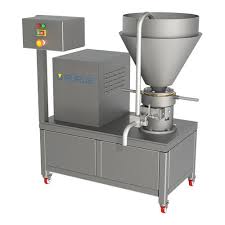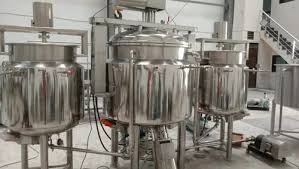|
Getting your Trinity Audio player ready... |
Colloid Mills: An In-Depth FAQ Guide
Colloid mills are essential machinery in a wide range of industries, most notably within the pharmaceutical sector. These machines are designed to break down chemical compounds into smaller molecules, enabling more efficient production processes. Their capability to create fine emulsions, suspensions, and mixtures makes them invaluable tools in pharmaceutical manufacturing and many other industries.
This guide is intended to provide a comprehensive overview of colloid mills, answering common questions about their features, operation, applications, energy consumption, and much more. Whether you are new to colloid mills or looking to deepen your understanding, this guide has the information you need.
What Is a Colloid Mills?
A colloid mill is a machine used to break down solid particles or liquid droplet sizes to their smallest molecular level. It is especially prominent in industries like pharmaceuticals, food production, and chemicals due to its capability to produce very fine mixtures. A colloid mill typically comprises an inlet and an outlet, with its key operation based on the rotor-stator principle.
The milling process occurs when a rotating cone and a static cone (the rotor and stator) come into contact and shear the material being processed. These cones are typically made from stainless steel or other durable materials like corundum, and their interaction results in the breakdown of the compounds into smaller parts.
What Is the Principle Behind a Colloid Mill?
The working principle of a colloid mill is based on the rotor-stator mechanism. The rotor is a rotating part of the machine, and the stator is a stationary component. Both parts are situated inside a cylindrical vessel. When the rotor spins, it creates shear forces as it moves against the stator. This results in the breakdown of solid materials into liquid or semi-liquid forms.
The material to be processed enters the mill via a hopper, where it then travels through a small gap between the rotor and stator. The shear force generated by the high-speed rotation of the rotor is crucial in breaking down the particles. The gap between the rotor and stator can often be adjusted to control the degree of shearing and particle size reduction.
The rotor typically operates at speeds between 3,000 and 20,000 RPM, depending on the material being processed. The shearing action, combined with high pressure, helps reduce compounds to their smallest possible molecules. The finished product exits through an outlet. If the material is not sufficiently sheared, it is cycled back into the mill for further processing.
What Are the Uses of a Colloid Mill?
Colloid mills are primarily used in pharmaceutical manufacturing but have diverse applications across other industries as well. Some of the most common uses include:
- Pharmaceutical Production: Colloid mills are instrumental in creating suspensions, emulsions, and homogeneous mixtures of solid compounds within liquids. They are also used for breaking down droplet sizes of liquids suspended in other liquids.
- Food Production: Colloid mills are used in the production of food items such as peanut butter, mayonnaise, jams, and sauces. The mill helps achieve a smooth and consistent texture by breaking down particles and ensuring even dispersion.
- Chemical Manufacturing: In the chemicals industry, colloid mills are used for emulsification, grinding, and creating micro-suspensions.
- Cosmetics: The cosmetic industry uses colloid mills to produce products like lotions, creams, and gels, ensuring consistent texture and smoothness.
- Paints and Inks: Colloid mills are used in the production of paints and inks to disperse pigments and achieve uniform consistency.
Colloid mills can break down particles as small as 3 microns, making them valuable tools for applications where fine particle size is essential.
What Is the Energy Consumption of a Colloid Mill?
The energy consumption of a colloid mill can vary depending on several factors, such as the type of material being processed, the viscosity of the liquid, and the temperature during the shearing process. Typically, colloid mills consume around 4 to 5 watt-hours per pound of material. This means that colloid mills are high-energy-consuming machines, and businesses need to account for this when considering their operational costs.
What Are the Benefits of a Colloid Mill?
Colloid mills offer a variety of advantages to manufacturing industries. These benefits include:
- Efficient Grinding and Shearing: Colloid mills can grind and shear solid and semi-solid materials efficiently, ensuring uniformity in the final product.
- Versatility: These mills can handle a wide range of products, including those with high viscosity, such as gels, creams, and pastes.
- Easy to Clean: The metallic surface of the rotor and stator is easy to clean, which is especially important for industries like pharmaceuticals and food production where hygiene is crucial.
- Operational under High Pressure: Colloid mills can operate under high-pressure conditions, up to 16 bar, which allows for better processing of materials.
- Particle Size Control: The gap between the rotor and stator can be adjusted to control the particle size reduction, providing more flexibility in the milling process.
- Reduced Noise: Modern colloid mills produce less noise compared to older models, making them more suitable for continuous operations.
- Durability: The materials used in colloid mills are generally wear-resistant, ensuring longevity and consistent performance.
What Are Some Drawbacks of a Colloid Mill?
Despite their many benefits, colloid mills also come with some drawbacks:
- Works Best with Liquids: Colloid mills are most effective when processing liquids and may not perform as well with solid materials.
- Wear and Tear: The rotating plates in colloid mills can wear out over time, especially when processing abrasive materials.
- Energy Consumption: As mentioned earlier, colloid mills require a significant amount of energy to operate, which can be costly in the long run.
- Expensive: The initial cost of a colloid mill can be high, making it an investment that may not be feasible for smaller businesses or startups.
What Materials Are Used in a Colloid Mill?
The materials used in colloid mills are designed to withstand the forces involved in the milling process. Typically, the rotor and stator are made from durable materials like stainless steel or other hard-wearing alloys. The machine components are carefully engineered to resist wear and corrosion, ensuring long-term reliability.
In addition to the rotor and stator, the inlet hopper, outlet, and other components are typically made from materials that are resistant to corrosion and easy to clean.
How Does a Colloid Mill Work?
The operation of a colloid mill begins when the material to be processed is introduced into the inlet hopper. The material is then forced through the narrow gap between the rotor and stator, where it undergoes a shearing action. The rotor spins at a high speed, causing the solid particles or liquid droplets to break down into smaller sizes.
The shearing action is enhanced by the addition of heavier liquids to the milling chamber, which facilitates the breakdown of lighter materials. The material is continuously processed, and once it reaches the desired particle size, it exits the machine through the outlet.
What Are the Prices of Colloid Mills?
Colloid mills can be quite expensive, with prices ranging from around $70,000 to $150,000 or more, depending on the features and specifications of the machine. The high cost is partly due to the energy requirements and the use of durable materials like stainless steel. For smaller businesses, this high cost can be a significant barrier to acquiring a colloid mill, although the long-term benefits may justify the investment.
What Are the Features of Colloid Mills?
Modern colloid mills come with a variety of features designed to improve their performance and ease of use:
- Simple Structure: Colloid mills have straightforward structures, which makes them easier to maintain and clean. Many models are designed for easy disassembly, allowing for thorough cleaning and sterilization.
- Heat and Water Resistance: Advanced colloid mills are equipped with heat and water-resistant components, ensuring they can operate under various processing conditions without damage.
- Stainless Steel Construction: Most colloid mills are made from stainless steel, which not only enhances their durability but also ensures hygiene and resistance to corrosion.
- Flameproof Electrical Fittings: Some models come with flameproof electrical fittings, making them suitable for hazardous environments.
What Is the Design of a Colloid Mill?
Colloid mills come in both vertical and horizontal designs, each with its unique advantages:
- Vertical Colloid Mills: These mills have a cone-shaped inlet hopper, where materials are introduced into the system. The rotor is mounted vertically, and the motor is linked to the rotor shaft. The milling action occurs in the narrow gap between the rotor and stator.
- Horizontal Colloid Mills: These mills have a lower height than vertical mills and are often used when continuous material processing is required. The discharge valve is positioned below the outlet to facilitate the long-term dispersal of materials.
Types of Colloid Mills
There are two main types of colloid mills: vertical and horizontal. Each type has distinct characteristics that make it suitable for different applications:
- Vertical Colloid Mills: These mills are typically used for smaller batches and when the vertical orientation is necessary to handle specific materials.
- Horizontal Colloid Mills: These are often preferred for larger production runs, as their horizontal design facilitates longer milling times and continuous processing.
Conclusion
Colloid mills play a vital role in industries where fine particle size reduction is critical. From pharmaceuticals to food production, these machines provide the ability to create smooth, uniform emulsions, suspensions, and mixtures. While they require a significant initial investment and consume considerable energy, their benefits make them indispensable for many manufacturing processes. Understanding their operation, uses, and maintenance requirements can help businesses optimize their processes and improve product quality.










Leave a Reply